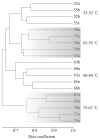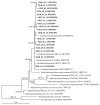Diversification of bacterial community composition along a temperature gradient at a thermal spring
- PMID: 22673306
- PMCID: PMC4103544
- DOI: 10.1264/jsme2.me11350
Diversification of bacterial community composition along a temperature gradient at a thermal spring
Abstract
To better understand the biogeography and relationship between temperature and community structure within microbial mats, the bacterial diversity of mats at a slightly alkaline, sulfide-containing hot spring was explored. Microbial mats that developed at temperatures between 75-52°C were collected from an area of approximately 1 m(2) in Nakabusa, Nagano, Japan. Bacterial 16S rRNA genes from these samples were examined by terminal restriction fragment length polymorphism (T-RFLP) and clone library analysis. T-RFLP profiles revealed 66 unique fragments (T-RFs). Based on total T-RFs observed in environmental profiles and clone libraries, a temperature effect on diversity was determined, with complexity in the community increasing as temperature decreased. The T-RF pattern indicated four distinct community assemblages related to temperature. Members of the Aquificales and particularly the sulfur-oxidizing bacterium Sulfurihydrogenibium were present at all temperatures and were the dominant component of mats taken at 75-67°C. Sulfide oxidation, which persisted throughout the temperature gradient, was the presumed dominant pathway of primary production above 67°C. As temperature decreased, successive additions of anoxygenic and oxygenic phototrophs increased primary productivity, allowing for diversification of the community.
Figures



References
-
- Albuquerque L, Rainey FA, Nobre MF, da Costa MS. Elioraea tepidiphila gen. nov., sp. nov., a slightly thermophilic member of the Alphaproteobacteria. Int J Syst Evol Microbiol. 2008;58:773–778. - PubMed
-
- Aguiar P, Beveridge TJ, Reysenbach A-L. Sulfurihydrogenibium azorense, sp. nov., a thermophilic hydrogen-oxidizing microaerophile from terrestrial hot springs in the Azores. Int J Syst Evol Microbiol. 2004;54:33–39. - PubMed
-
- Azam F. Microbial control of oceanic carbon flux: the plot thickens. Science. 1998;280:694–696.
-
- Bowman KS, Moe WM, Rash BA, Bae H-S, Rainey FA. Bacterial diversity of an acidic Louisiana groundwater contaminated by dense nonaqueous-phase liquid containing chloroethanes and other solvents. FEMS Microbiol Ecol. 2006;58:120–133. - PubMed
Publication types
MeSH terms
Substances
Associated data
- Actions
- Actions
- Actions
- Actions
- Actions
- Actions
- Actions
- Actions
- Actions
- Actions
- Actions
- Actions
- Actions
- Actions
- Actions
- Actions
- Actions
- Actions
- Actions
- Actions
- Actions
- Actions
- Actions
- Actions
- Actions
- Actions
- Actions
- Actions
- Actions
- Actions
- Actions
- Actions
- Actions
- Actions
- Actions
- Actions
- Actions
- Actions
- Actions
- Actions
- Actions
- Actions
- Actions
- Actions
- Actions
- Actions
- Actions
- Actions
- Actions
- Actions
- Actions
- Actions
- Actions
- Actions
LinkOut - more resources
Full Text Sources
Molecular Biology Databases
Research Materials

